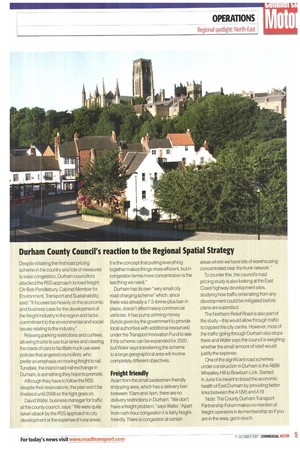Durham County Council's reaction to the Regional Spatial Strategy
Page 53

If you've noticed an error in this article please click here to report it so we can fix it.
Despite initiating the first road pricing scheme in the country and lots of measures to ease congestion, Durham councillors attacked the RSS approach to road freight. CIIr Bob Pendlebury, Cabinet Member for Environment, Transport and Sustainability, said: "It focuses too heavily on the economic and business case for the development of the freight industry in the region and lacks commitment to the environmental and social issues relating to the industry."
Relaxing parking restrictions and curfews, allowing trucks to use bus lanes and clearing the roads of cars to facilitate truck use were policies that angered councillors, who prefer an emphasis on moving freight to rail. Tursdale, the inland road-rail exchange in Durham, is something they hope to promote.
Although they have to follow the RSS despite their reservations, the plan won't be finalised until 2008 so the fight goes on.
David Wafer, business manager for traffic at the county council, says: "We were quite taken aback by the RSS approach to city development at the expense of rural areas. It is the concept that putting everything together makes things more efficient, but in congestion terms more concentration is the last thing we need."
Durham has its own "very small city road charging scheme" which, since there was already a 7.5-tonne-plus ban in place, doesn't affect heavy commercial vehicles. It has pump priming money (funds given by the government to provide local authorities with additional resources) under the Transport Innovation Fund to see if the scheme can be expanded for 2020, but Wafer says transferring the scheme to a large geographical area will involve completely different objectives.
Freight friendly
Apart from the small pedestrian-friendly shopping area, which has a delivery ban between 10am and 4pm, there are no delivery restrictions in Durham. "We don't have a freight problem," says Wafer. "Apart from rush-hour congestion it is fairly freightfriendly. There is congestion at certain areas where we have lots of warehousing concentrated near the trunk network."
To counter this, the council's road pricing study is also looking at the East Coast highway development sites, studying how traffic emanating from any development could be mitigated before plans are submitted.
The Northern Relief Road is also part of the study —this would allow through traffic to bypass the city centre. However, most of the traffic going through Durham also stops there and Wafer says the council is weighing whether the small amount of relief would justify the expense.
One of the significant road schemes under construction in Durham is the A688 Wheatley Hill to Bowburn Link. Started in June it is meant to boost the economic health of East Durham by providing better links between the Al (M) and A19 Note: The County Durham Transport Partnership Forum makes no mention of freight operators in its membership so if you are in the area, get in touch.


































































































































































































